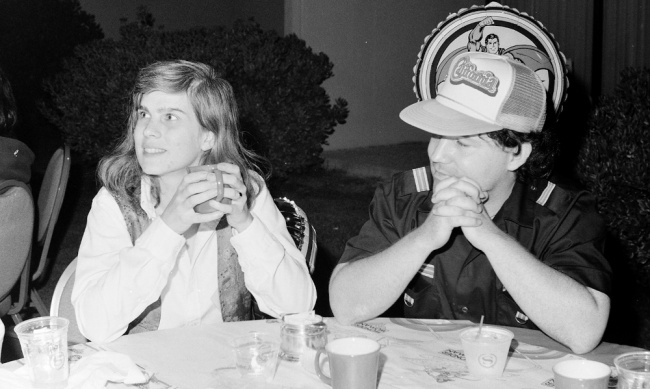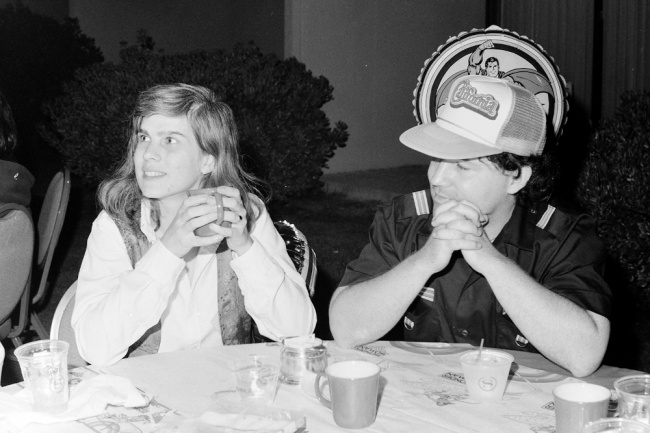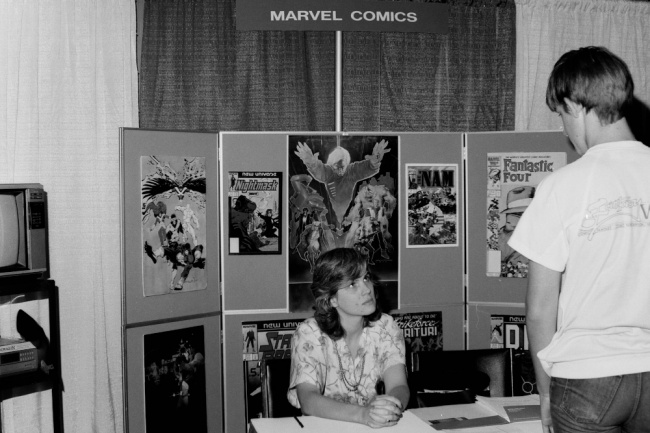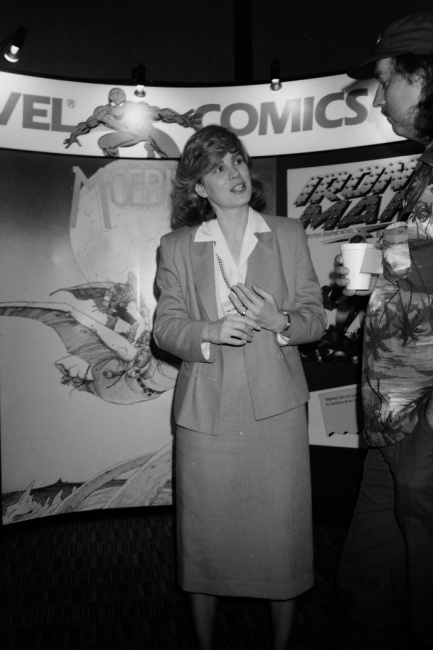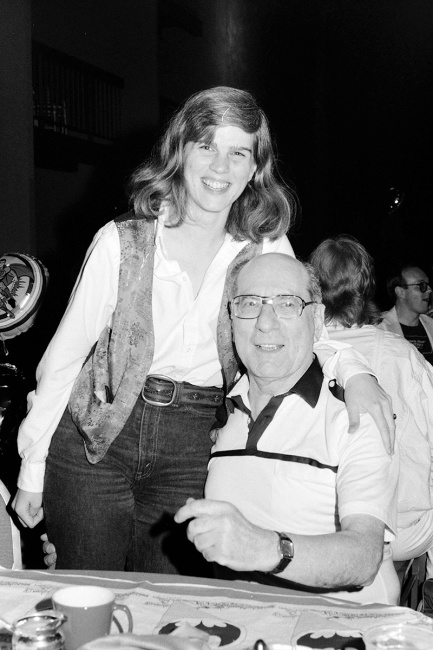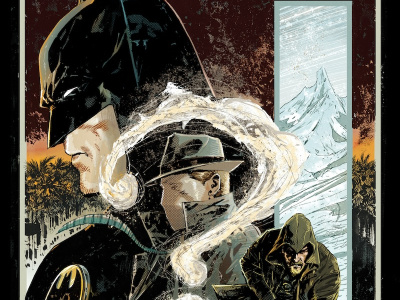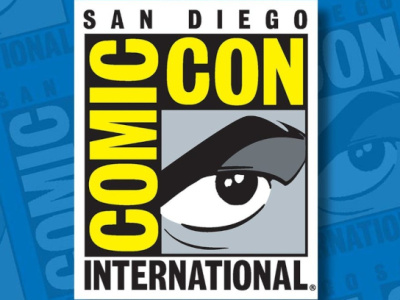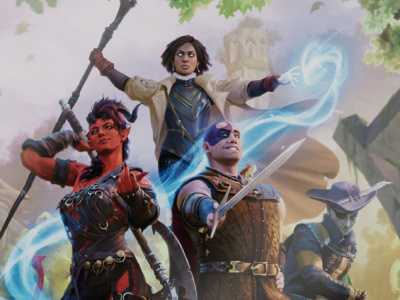Carol Kalish was the right person in the right place at the right time. The time was the early 1980s. The place was the offices of Marvel Comics. The person was a woman who understood both the business of comics and the realities of comics retailing and helped them work together, making the Direct Market sustainable for the long term. Kalish died suddenly in 1991, just a few months after being promoted to Vice President of New Product Development at Marvel. Her untimely death may have changed the history of comics as we know them.
Kalish was born in 1955 and became a comics fan at an early age, possibly with some parental help. “Carol’s mother had a crush on the Sub-Mariner,” recalls Richard Howell, her life partner, “so when Fantastic Four #4 came out, she saw it on the newsstands and said ‘We’re buying this!’” Kalish would have been about seven at the time. Certainly by the time she arrived at Harvard she was interested enough to join the comics club there, where she met Howell. Despite his attempts to catch her eye when he was waiting tables at the Freshman Union, they didn’t really click until after graduation, when he was working at the Cambridge, MA, comics shop The Million Year Picnic. When he moved on to Newbury Comics, Carol also got a job there; he was doing typesetting and she was working the cash register and dealing with customers.Their next move was to New Media/Irjax, an early distributor that had changed the course of comics distribution with its 1978 lawsuit against several publishers that broke Sea Gate’s monopoly on direct comics distribution and opened up the field to a host of competitors (see “Phil Seuling: The Man Who Invented the Direct Market”). Kalish and Howell started working for New Media in 1980. “Like many other companies, they decided that the way to get people to buy their Marvel comics or their mainstream comics every month was to offer exclusive content,” said Howell. He and Kalish edited the company’s Comics Feature magazine, and Howell also edited the sole issues of two comics, Adventure Illustrated and Fantasy Illustrated.
When Irjax opened a New England division, Solar Spice and Liquors, the couple worked there as well. “Since Carol had a much better business mind than I did, she took over managing Solar Spice, and I continued producing the text magazines and eventually the comic books,” Howell said. Thus, by her mid-20s, Kalish already had experience in both retail sales and distribution.
“She was the most intelligent person I had met in comics,” said Mike Friedrich, who had become Marvel’s first Direct Sales Manager in 1980 (see “ICv2 Interview: Mike Friedrich”) and met Kalish when he was making the rounds of distributors, “ and she really had a handle on what the market was about as a whole, not just her local area. The way she talked about the accounts she worked with was much more sophisticated than almost any other.”
When Friedrich got the green light to hire an assistant, in fall of 1981, he invited Kalish to apply. “She was just the best candidate all around,” he said. So Kalish and Howell packed up their household, including their three cats, and moved to New Jersey, where she had an easy commute to the Marvel offices and Howell, who was beginning his career as a comics artist, could visit the publishers.
“We were on the same page about a lot of different things,” Friedrich said, and that was just as well, because as he told her on her first day, he was already planning to leave Marvel, although he hadn’t told anyone else that yet. “She knew she was studying for my job, not her job,” he said.
This was about the same time that New Media/Irjax went out of business, and Friedrich spent much of his remaining time on the job sorting out the aftermath. “It was a very entrepreneurial field,” he said, “and people were going out of business all the time, so we had to be alert to who might be in trouble. So there was that, plus figuring out which of the upcoming editorial product would be the best things to promote, and then we would work with some in-house talent to create promotional material.”
Since the Direct Market was new at the time and unprecedented in comics, Friedrich and Kalish were working without a roadmap. “We had no experience dealing with specialty markets other than the one that we had,” he said, “so it was really just a matter of combining what people would ask for with our own best instincts, and then of course, keeping track of the internal politics at Marvel to figure out what might get accepted and what would run into resistance.”
As newsstand distribution dwindled, Friedrich and Kalish built an essential bridge between Marvel and Direct Market retailers. “Mike Friedrich was the first person at any of the major comic companies that a retailer could talk to and get more than a two-sentence answer,” said Paul Levitz, who was an editor at DC at the time and later became president of the company, “and Carol continued and broadened out that tradition.” For both Friedrich and, later, Kalish, the job involved a lot of travel to visit distributors, and the distributors would introduce them to retailers. Kalish, who by all accounts had a deep love and knowledge of comics and a self-deprecating sense of humor, got along well with them. “She was a very ground-level human being and a very smart woman, but not pretentions,” Levitz recalled. Perhaps that, as well as her accessibility, was why her advice was often well received.She is best remembered for initiating a program to help retailers get cash registers for their stores, but there were other triumphs as well. Howell recalls her suggesting to a retailer that he not keep a glass case with a large snake in it in the front of his store.
The job was not without its frustrations. Women were still rare in the comics industry in the 1980s, especially in the upper echelons, with Jenette Kahn, Publisher and President of DC, being the notable exception. Howell recalls that when another woman got pregnant, Marvel had no provision for maternity leave.Carol didn’t talk about her job much at home, Howell said, but he does remember her being frustrated with the way Marvel treated its freelancers (including him). “There was one point where she came home and said ‘I’m leaving Marvel. I’m going to start my own company.’” The moment passed, however (he estimates it was in 1984 or so) and she stayed on.
About a year before she died, Kalish was promoted to Vice President for Special Projects and began working on ways to expand comics beyond the Direct Market, such as developing historical comics to be sold at Civil War battleground gift shops, religious comics, and even eight-page greeting-card comics. None of these projects came to fruition, in part, Howell said, because of conflicts with the editorial side..
On September 5, 1991, as she was walking to the Marvel offices from the train, Kalish collapsed. She died a few hours later of a pulmonary embolism at the age of 36. Her death was a shock to the industry, because she was so young and apparently healthy. Terry Stewart, who was president of Marvel Comics at the time, arranged a memorial service for her in the ballroom of the Commodore Hotel (now the Hyatt Grand Central New York), which had been the dealers room for the early comic cons run by Phil Seuling in the 1970s.
Although she was at Marvel for less than 10 years, Kalish was influential in many ways. “I think she helped multiply the comic shops and keep them alive in that very early period,” Levitz said. “I don't mean it in a motherly fashion. Carol was not a motherly type. But these were really fragile little businesses.” Helping them get cash registers or extra copies, telling them to pay attention to one title and maybe not order too many copies of a weaker one, may have helped some retailers stay in business or perhaps bring home steak rather than Hamburger Helper. “It's a very ground level sort of benefit to the individual people, but also net to the industry,” he said.
Retailer Chuck Rozanski, who had his share of run-ins with Kalish over the years, paid her tribute as well. “I have enormous respect for her legacy and for the great things that she did for the Direct Market,” he said, “and I think that the Direct Market would have benefited enormously from her continuing to be around. I think that some of the faults that are in the system today might have been mitigated, because she was incredibly smart.”
“She had a very dry sense of humor, which appealed to me, because I do too,” Friedrich said. “What I lost when she died was that she was the one person I could spend time talking about the future of comics in an imaginative way. You know, ‘If we did this, and this and this, and this, we get this result. We should try to figure out how to do this thing.’ And we wouldn't have those kinds of conversations every time we got together.”
Kalish’s work benefited the industry as a whole, Levitz said. “On the front line level, Carol was doing a very effective job,” he said, “and if that meant the comic shops survive, or a comic shop had a couple more bucks to invest in the next number one thing that was coming out, whether it was coming out from us or from Marvel or from Pacific, First, Eclipse, whoever was coming into the business at that time, that was good for us. Anything that helps the business was good for the business overall.”
Howell summed it up most succinctly: “It's my opinion that the world lost a great person and a great force for the comics industry when Carol passed away,” he said.
This article is part of ICv2's Comics Direct Market 50th Anniversary celebration; for more, see "Comics Direct Market 50th Anniversary."



